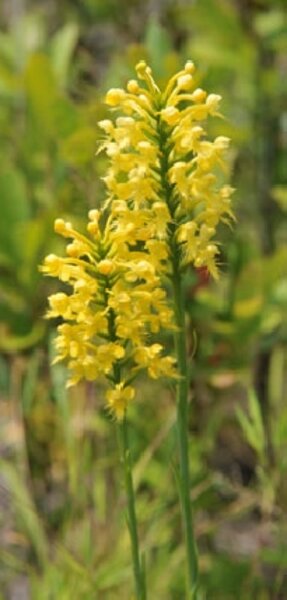Rare orchid rises from burned Maryland preserve
Loading...
The managers of Maryland's largest private nature preserve burned 240 acres this spring in the hopes of triggering the growth of long-dormant native plants. The plan worked, producing a rare hybrid orchid that has only been found in Maryland once before — 18 years ago. Botanist Ron Wilson made the dazzling find in late July at the Nassawango Creek Preserve on the Eastern Shore, where the charred woodlands and prairies have responded with the appearance of rare native plants.
He found three specimens of a naturally occurring hybrid of the white fringed orchid and the crested yellow orchid. These species are uncommon enough, but the hybrid has only been found in Maryland once before — by Wilson and another botanist almost two decades ago at another Maryland site. It is known by its botanic name, Platanthera x canbyi.
"It's hard to explain to a non-botanist, but you go to site after site that has literally nothing as far as rare plants go, and find something like this," Wilson said. "It makes it all worth it."
From ground-hugging, straplike leaves, the hybrid sends up a 12 inch flowering stalk in summer, but the blooms are a lemon yellow in contrast to the white and orange blooms of the parent species.
The controlled fires were set between March and May with the help of a $55,000 federal grant and represented the largest annual burns to date at the 10,000-acre preserve, said Deborah Landau, conservation ecologist for the Nature Conservancy's Maryland/Washington, D.C. chapter.
The fires eradicate unwanted trees, shrubs and weeds, add nitrogen to the soil and trigger responses from plants that evolved to grow after natural wildfires.
Wilson surveyed the areas last year and found seven white fringed orchids and no crested yellow orchids. This year, in addition to the appearance of the hybrid, Wilson found more than 50 white fringed and more than 20 crested yellow orchids. The fires have also encouraged the appearance of other rare plants, including sedges and grasses.
"To see such a dramatic change so quickly after the fire is a vindication, to see things that haven't been seen essentially in 70 years," said Landau.
Editor’s note: For more on gardening, see the Monitor’s main gardening page. Our blog archive. Our RSS feed.
You may also want to visit Gardening With the Monitor on Flickr. If you join the group (it’s free), you can upload your garden photos. Join the discussions and get answers to your gardening questions.





